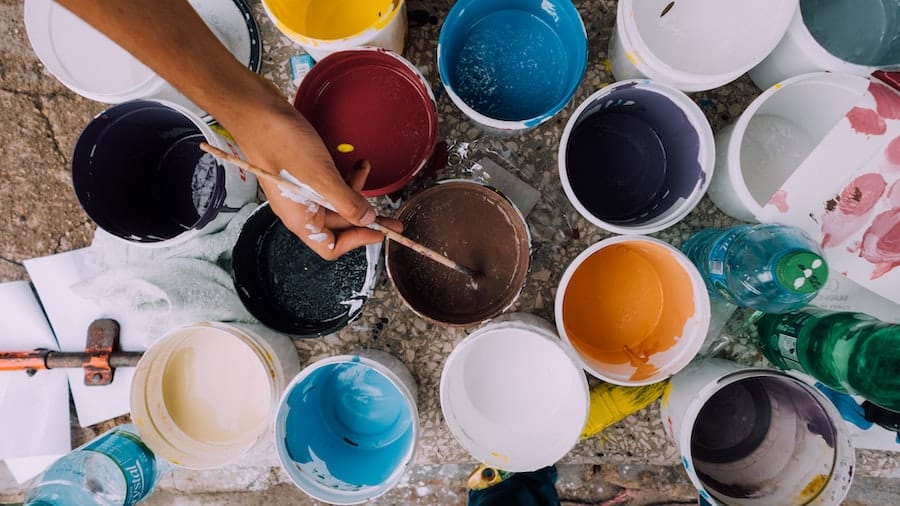The Master of Fine Arts (MFA) degree is a postgraduate degree that focuses on the development of artistic skills and knowledge in various creative disciplines such as visual arts, performing arts, creative writing, and more. It is a program designed for individuals who are passionate about their craft and want to further enhance their artistic abilities.
The MFA program typically spans two to three years and provides students with a structured curriculum that includes both theoretical and practical components. Students have the opportunity to work closely with experienced faculty members and fellow artists, allowing for a collaborative and supportive learning environment.
Table of Contents

Why Pursue an MFA?
- Artistic Enhancement: An MFA program offers an environment to develop talents and deepen your understanding of your artistic practice.
- Professional Development: The degree can prepare you for various professional roles and enhance your skills in critical thinking and communication.
- Networking: You build lasting connections with mentors and peers, which are crucial for your professional life as an artist.
Opportunities and Career Prospects
MFA graduates have diverse career paths open to them, including roles as Creative Directors, Product Designers, Video Producers, Copywriters, and Interior Designers. These roles offer a blend of creativity and practical application, with salaries varying based on the specific job and location.
Admission Requirements and Choosing the Right Program
Admission Requirements
To apply for an MFA program, you typically need:
- A bachelor’s degree (not necessarily in the same field)
- A statement of purpose
- Transcripts
- GRE scores (in some cases)
- An academic resume
- Recommendation letters
- A portfolio of your art or design pieces
Choosing the Right Program
When selecting an MFA program, consider:
- Specialization: Ensure the program aligns with your artistic interests.
- Location: Consider the geographical location for its access to art communities and resources.
- Faculty and Mentors: Quality of faculty can significantly impact your learning experience.
- Funding: Understand tuition costs and explore funding options like scholarships.
- Program Format: Decide between on-campus, online, or hybrid formats based on your lifestyle and commitments.
Institutions and Program Variations
Some notable institutions offering MFA programs include:
- New York Film Academy (NYFA): Known for its rigorous creative environment, NYFA offers diverse MFA programs including Filmmaking, Acting for Film, Screenwriting, and Game Design.
- Drexel University: Offers an MFA in Creative Writing with a low-residency, mostly online format.
- Boston University: Provides an online Master of Music in Music Education, focusing on psychological, philosophical, and sociological theories.
Each of these institutions offers unique aspects to their MFA programs, catering to different artistic disciplines and learning preferences.
How a Master of Fine Arts Degree Can Help You Unleash Your Creative Potential
One of the key benefits of pursuing an MFA degree is that it encourages experimentation and exploration. The program provides a safe space for artists to take risks and push the boundaries of their creativity. Students are encouraged to try new techniques, explore different mediums, and think outside the box.
This freedom to experiment allows artists to discover new ways of expressing themselves and unleashing their full creative potential.
In addition to fostering experimentation, the MFA program also provides a supportive environment for creativity. Students have access to dedicated studio spaces, state-of-the-art facilities, and resources that enable them to fully immerse themselves in their artistic practice. The program also offers regular critiques and feedback sessions, where students can receive constructive criticism from faculty members and peers. This supportive environment helps artists grow and develop their skills in a nurturing and encouraging atmosphere.
Furthermore, pursuing an MFA degree helps artists develop a unique artistic voice. Through the program’s curriculum, students are exposed to various art forms, techniques, and theories that broaden their artistic horizons. They have the opportunity to explore different styles, experiment with different mediums, and develop their own personal aesthetic. This process of self-discovery allows artists to find their own unique voice and establish a distinct identity in the art world.
Developing Your Artistic Skills and Knowledge through a Master of Fine Arts Degree
One of the primary goals of an MFA program is to enhance students’ artistic skills and knowledge. The program offers a structured curriculum that is designed to provide a comprehensive education in the chosen creative discipline. Students take a combination of core courses and electives that cover various aspects of their field, including technique, theory, history, and criticism.
The MFA program also provides access to resources and facilities that are essential for artistic development. Students have access to well-equipped studios, specialized equipment, and materials that enable them to fully explore their chosen medium. They also have the opportunity to work closely with faculty members who are experienced artists themselves, gaining valuable insights and guidance.
Furthermore, the MFA program encourages interdisciplinary learning. Students have the flexibility to take courses outside of their primary discipline, allowing them to explore different art forms and techniques. This interdisciplinary approach helps artists develop a broader perspective and a more diverse skill set, which can be invaluable in their artistic practice.
The Importance of Mentorship and Networking in the Master of Fine Arts Program
One of the unique aspects of an MFA program is the opportunity to work with experienced artists as mentors. Faculty members in the program are typically accomplished artists themselves, with extensive knowledge and experience in their respective fields. They provide guidance, support, and feedback to students throughout their artistic journey.
Mentorship plays a crucial role in career development for MFA students. Mentors can offer valuable insights into the industry, provide advice on professional opportunities, and help students navigate the art world. They can also serve as a source of inspiration and motivation, pushing students to reach their full potential.
In addition to mentorship, the MFA program also offers opportunities for networking. Students have the chance to connect with fellow artists, visiting artists, gallery owners, and other professionals in the art world. These connections can lead to collaborations, exhibitions, and other career opportunities. Building a strong professional network is essential for artists, and the MFA program provides a platform for students to establish these connections.
The Benefits of Collaborative Learning in Master of Fine Arts Programs
Collaborative learning is a key component of many MFA programs. Students have the opportunity to work collaboratively with their peers on various projects, fostering teamwork and communication skills. This collaborative approach encourages artists to learn from each other, share ideas, and gain different perspectives.
Peer feedback and critique are also integral to the collaborative learning environment of an MFA program. Students regularly present their work to their peers and receive constructive criticism and feedback. This feedback helps artists refine their work, identify areas for improvement, and develop a critical eye for their own art. It also helps them develop the ability to give and receive feedback, an essential skill in the art world.
Furthermore, collaborative learning in an MFA program helps students develop a sense of community and belonging. They become part of a close-knit group of artists who share similar passions and aspirations. This sense of community provides emotional support, inspiration, and motivation throughout the program and beyond.
The Role of Critique and Feedback in Enhancing Your Creative Abilities
Critique and feedback are integral components of the MFA program. Regular critique sessions provide students with valuable insights into their work from faculty members and peers. This constructive criticism helps artists identify strengths and weaknesses in their work, allowing them to make improvements and grow as artists.
Receiving critique also helps artists develop a critical eye for their own work. They learn to objectively evaluate their art, identify areas that need improvement, and make informed decisions about their creative choices. This ability to self-critique is essential for artistic growth and development.
Moreover, critique sessions encourage artists to embrace growth and change. They learn to view criticism as an opportunity for improvement rather than a personal attack. This mindset shift allows artists to continuously evolve and refine their work, pushing the boundaries of their creativity.
The Opportunities for Professional Growth and Career Advancement with a Master of Fine Arts Degree
One of the primary goals of pursuing an MFA degree is to advance one’s artistic career. The program provides access to various job opportunities and internships in the art world. Students have the chance to work with established artists, galleries, museums, and other art organizations, gaining valuable experience and exposure.
The MFA program also helps artists build a strong portfolio and resume. Through the program’s coursework, students create a body of work that showcases their artistic abilities and unique style. They also have the opportunity to participate in exhibitions, shows, and other public events, further enhancing their portfolio.
Furthermore, the MFA program offers opportunities for artists to exhibit their work and gain recognition in the art world. Many programs organize annual exhibitions or showcases where students can display their art to a wider audience. These exhibitions provide exposure and networking opportunities that can lead to further career advancement.
The Benefits of Exposure to Different Art Forms and Techniques in Master of Fine Arts Programs
One of the advantages of pursuing an MFA degree is the exposure to different art forms and techniques. The program encourages artists to explore various mediums, styles, and approaches to art-making. This exposure allows artists to expand their artistic horizons, develop a diverse skill set, and gain a deeper understanding of different artistic traditions.
By experimenting with different art forms and techniques, artists can discover new ways of expressing themselves and find inspiration in unexpected places. They can incorporate elements from different disciplines into their own work, creating unique and innovative pieces. This interdisciplinary approach helps artists develop a broader perspective and a more versatile artistic practice.
Moreover, exposure to different art forms and techniques also provides opportunities for learning from different artists and cultures. MFA programs often invite visiting artists from various backgrounds to give lectures, conduct workshops, and share their experiences. This exposure to different perspectives and artistic traditions enriches the learning experience and broadens students’ artistic knowledge.
How a Master of Fine Arts Degree Can Help You Build a Strong Portfolio and Brand
Building a strong portfolio and personal brand is essential for artists looking to establish themselves in the art world. An MFA program provides numerous opportunities for students to showcase their work and gain exposure.
Many MFA programs organize annual exhibitions or showcases where students can display their art to a wider audience. These exhibitions provide a platform for artists to present their work, receive feedback, and make connections with industry professionals. They also offer opportunities for artists to sell their work and gain recognition.
Additionally, the MFA program helps artists develop a personal brand and style. Through the program’s curriculum, students have the chance to explore different artistic approaches, experiment with different techniques, and develop their own unique aesthetic. This process of self-discovery allows artists to establish a distinct identity in the art world and differentiate themselves from other artists.
Furthermore, MFA programs often provide resources and support for marketing and promotion. Students learn how to effectively market their work, create a professional website or portfolio, and utilize social media platforms to reach a wider audience. These skills are essential for artists looking to establish a successful career in the arts.
Why Pursuing a Master of Fine Arts Degree is Worth the Investment
In conclusion, pursuing a Master of Fine Arts degree is a valuable investment for individuals looking to unleash their creative potential and advance their artistic careers. The program offers a supportive environment that encourages experimentation, provides access to resources and facilities, and fosters interdisciplinary learning.
MFA programs also provide opportunities for mentorship and networking, allowing students to work with experienced artists, receive guidance and support for career development, and build a professional network. Collaborative learning and critique sessions help artists develop teamwork and communication skills, receive feedback and critique, and develop a sense of community.
Moreover, MFA programs offer opportunities for professional growth and career advancement, providing access to job opportunities, helping artists build a strong portfolio and resume, and offering opportunities for exhibitions and shows. Exposure to different art forms and techniques helps artists develop a diverse skill set, learn from different artists and cultures, and expand their artistic horizons.
Overall, pursuing a Master of Fine Arts degree is a worthwhile investment for artists who are passionate about their craft and want to take their artistic abilities to the next level. It provides the necessary tools, resources, and support to help artists unleash their creative potential, develop their skills and knowledge, build a strong portfolio and brand, and establish a successful career in the arts.
Conclusion
Pursuing an MFA can be a significant step in your artistic career, offering opportunities for professional growth, skill enhancement, and valuable networking. However, it’s crucial to carefully consider your goals, financial situation, and the specifics of each program before making a decision.
For more detailed information on MFA programs, you can visit the resources at Artsy Symposia, The Gradcafe, and NYFA.
FAQs
What is a Master of Fine Arts degree?
A Master of Fine Arts (MFA) degree is a graduate-level degree in the field of visual arts, creative writing, or performing arts. It is typically a two- to three-year program that focuses on advanced study and practice in a specific artistic discipline.
What are the requirements for admission to an MFA program?
The requirements for admission to an MFA program vary depending on the school and program. Generally, applicants must have a bachelor’s degree, a portfolio or writing sample, letters of recommendation, and a statement of purpose. Some programs may also require GRE scores.
What can I do with an MFA degree?
An MFA degree can lead to a variety of careers in the arts, including working as a professional artist, writer, or performer. Graduates may also work in arts administration, education, or other related fields.
How much does an MFA program cost?
The cost of an MFA program varies depending on the school and program. According to the College Board, the average cost of tuition and fees for a graduate program in the arts is $37,000 per year at a public institution and $48,000 per year at a private institution.
What is the difference between an MFA and a Master of Arts (MA) degree?
An MFA degree is a specialized degree that focuses on advanced study and practice in a specific artistic discipline, while an MA degree is a more general degree that can be earned in a variety of fields, including the arts. An MA degree typically requires a thesis or research project, while an MFA degree requires a creative project or portfolio.
 Unlocking Career Opportunities with a Masters in Law Degree
Unlocking Career Opportunities with a Masters in Law Degree American Degree Transfer Program: Your Path to Success in US Universities
American Degree Transfer Program: Your Path to Success in US Universities Discover the Charm of OSU Stillwater: A Hidden Gem in America’s Heartland
Discover the Charm of OSU Stillwater: A Hidden Gem in America’s Heartland Online Programs for Bachelor’s Degree: Explore Convenient and Quality Higher Education Options
Online Programs for Bachelor’s Degree: Explore Convenient and Quality Higher Education Options What is a Computer Information Systems Degree?
What is a Computer Information Systems Degree?